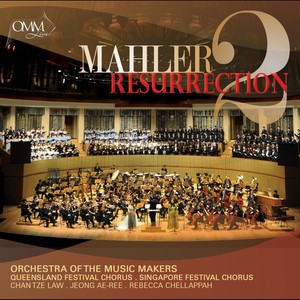
- 歌曲
- 时长
-
作曲家:Gustav Mahler
-
作品集:Symphony No. 2 "Resurrection" in C Minor
简介
Review from Fanfare Magazine: On July 10 of last year I attended in Singapore one of the most thrilling performances of Mahler’s Second Symphony I have ever heard. That it was given by an orchestra consisting primarily of young musicians (most in their late teens and early 20s) who are not pursuing professional careers in music and who do not play together every week made the event all the more remarkable. That performance is now available on disc. Singapore’s Orchestra of the Music Makers (OMM), the subject of a feature story in Fanfare 34:2, came into existence barely four years ago when a group of graduates from several of Singapore’s high schools with advanced music programs asked a prominent local conductor, Tze Law Chan, to help them form an orchestra and to be their leader. At first skeptical, he soon realized the seriousness of their intent, and OMM was born. The slightly cumbersome yet poetic name comes from the title of a poem by the 19th-century author Arthur O’Shaughnessy, later gorgeously set by Elgar as an oratorio. Their first recorded venture, Mahler’s First Symphony, was reviewed in highly favorable terms in the aforementioned issue of Fanfare. The Second Symphony surpasses that effort by a good margin. The very first bars serve notice that this is going to be a performance radiating fierce energy and laser-like intensity. Those opening salvos from the cellos and basses, tossed off with technical bravado, strike a note of sheer terror that does not abate until the sublime second theme arrives. Throughout, conductor Chan paces the climaxes so adroitly that, when they arrive, the listener is nearly swept out of the room on tidal waves of sound. The percussion section, though never out of control, is so powerful that I can recall no other, even from the greatest orchestras, that makes a more magnificent contribution to this symphony. Never, in half a century listening to dozens of performances of this work, have I heard that long, agonizing crescendo from the percussion in the finale build to such a deafening roar. In fact, Chan told me that it actually blew out his expensive German Rainbow speakers while listening to the playback. (The passage had to be slightly compressed on the CD.) Aside from the fact that the musicians are not paid, there is nothing to suggest that OMM is not a full-time professional orchestra. Ensemble is tight, balances are well judged, rhythms are precise. I detect not a single missed note and, while touch-up sessions are common for live performances transferred to recording, only a few spots taken from the dress rehearsal were used here. The Andante moderato begins a bit raggedly, and attention throughout this movement seems to flag, but it is regained in the Scherzo, set in motion by electrifying shots from the timpani. Mention must also be made of the principal trumpet, Nuttapong Veerapun, who soars effortlessly over the orchestra; of the offstage horns in the finale, who fearlessly go for—and nail—the high C (a moment that can turn seasoned professionals to jelly); the sumptuous organ at Singapore’s Esplanade Concert Hall in the symphony’s crowning moments; the fully professional contribution of the Queensland Festival Chorus (from Brisbane) and the Singapore Festival Chorus; and the gorgeous, perfectly balanced brass chorales in the “Urlicht” movement and the finale. In short, this “Resurrection” can stack up to any other on disc you care to name. It has virtually everything going for it: technical perfection, unstinting energy, assured musicians not afraid of dynamic extremes, a percussion section that gives new meaning to the word “awesome,” a conductor with the full measure of the Mahlerian idiom securely in hand and, above all, the thrill of a live performance brought vividly to life. It is a recording to which I will return again and again with great pleasure. Robert Markow







